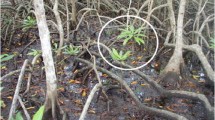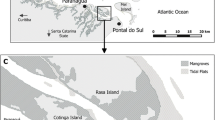Abstract
Amounts of seed predation by grapsid crabs (Brachyura: Grapsidae) on two species of mangroves (Aegiceras corniculatum and Avicennia marina) were compared among different habitats in an Australian mangrove forest. For Avicennia, comparisons were between canopy gaps and the adjacent forest understory for six, mid intertidal, gaps of different sizes. For Aegiceras the comparisons were among canopy gaps in the high intertidal; open, accreting mud/sand banks where mangroves were colonizing in the low intertidal; and in the forest understory in both the high and low intertidal zones. These were repeated in the high salinity (35\%) downstream portion and the low salinity (0–5\%) upstream portion of a tidal river.
Predation on Avicennia was significantly higher in the understory than in adjacent canopy gaps. Within a canopy opening, predation was greatest in the smallest gaps and lowest in the largest gaps. Predation on Aegiceras was greater in the high intertidal compared to the low intertidal, but no differences were found between river mouth and upstream locations. In the high intertidal zone of the forest, there were no differences in predation between canopy gap or forest understory sites for Aegiceras. In the low intertidal zone, however, significant differences in amount of predation were found between habitats. More Aegiceras propagules were consumed in the understory than on adjacent accreting sandbanks.
Frequency of tidal inundation, which in turn affects the amount of time available to forage, is hypothesized to account for differences in predation between low and high intertidal forests and between small and large canopy gaps. Our results also suggest that ‘shade intolerance’ in these two species may actually reflect an escape from predators, successful when the seeds are dispersed into open areas such as canopy gaps or mud banks.
Similar content being viewed by others
References
Augspruger C. K. 1984. Seedling survival among tropical tree species: interactions of dispersal distance, lightgaps and pathogens. Ecology 65: 1705–1712.
Augspruger C. K. & Kelly C. K. 1984. Pathogen mortality of tropical tree seedlings: Experimental studies of the effects of dispersal distance, seedling density and light conditions. Oecologia 61: 211–217.
Davie P. 1982. A preliminary checklist of the Brachyura (Crestacea: Decapoda) associated with Australian mangrove forests. Operculum 5: 204–207.
Denslow J. S. 1987. Tropical rainforest gaps and tree species diversity. Ann. Rev. Ecol. & Syst. 18: 431–451.
Frith D. W., Tantanasiriwong R. & Bhatia O. 1976. Zonation of macrofauna on a mangrove shore. Research Bulletin i0. Phuket Marine Biological Center, Phuket, Thailand. 37 pp.
Hartnoll R. G. 1975. The Grapsidae and Ocypodidae (Decapoda: Brachyura) of Tanzania. J. Zool. (London) 177: 305–328.
Jones D. A. 1984. Crabs of the mangal ecosystem. In: Por F. D. & Dor I. (eds), Hydrobiology of the mangal. pp. 89–109, Dr. W. Junk Publ. The Hague.
Osborne, K. 1988. A distribution study of the mangrove, Aegiceras corniculatum (L.) Blanco, in some Northern Australian estuaries. B.Sc. Honours Thesis. Dept. of Geography, James Cook University of North Queensland. Townsville, Queensland, Australia.
Poole R. W. 1974. An introduction to quantitative ecology. McGraw-Hill, New York.
Saenger P. 1982. Morphological, physiological and reproductive adaptations of Australian mangroves. In: Clough B. F. (ed), Mangrove ecosystems in Australia. pp. 153–192. Australian National University Press, Canberra.
Sasekumar A. 1974. Distribution of macrofauna on a Malayan mangrove shore. J. Anim. Ecol. 43: 51–69.
Sasekumar A., Ong T. L. & Thong K. L. 1984. Predation of mangrove fauna by fishes. In: Soepadmo E., Rao A. N. & MacIntosh D. J. (eds), Proceedings of the Asian Symposium on Mangrove Environments: Research & Management. pp. 378–384, Percetakan Ardyas Sdn. Bhd., Kuala Lumpur, Malaysia.
Schupp E. W. 1988a. Factors affecting post-dispersal seed survival in a tropical forest. Oecologia (Berlin) 76: 525–530.
Schupp E. W. 1988b. Seed and early seedling predation in the forest understory and in treefall gaps. Oikos 51: 71–78.
Schupp E. W. & Frost E. J. (1989) Differential predation of Welfia georgii seeds in treefall gaps and the forest understory. Biotropica 21: 200–203.
Smith T. J.III. 1987a. Seed predation in relation to tree dominance and distribution in mangrove forests. Ecology 68: 266–273.
Smith T. J.III. 1987b. Effects of seed predators and light level on the distribution of Avicennia marina (Forsk.) Vierh. in tropical, tidal forests. Est. Coast. & Shelf Sci. 25: 43–51.
Smith T. J.III. 1987c. Effects of light and intertidal position on seedling survival and growth in tropical, tidal forests. J. Exp. Mar. Biol. & Ecol. 110: 133–146.
Smith T. J.III. 1988. The influence of seed predators on structure and succession in tropical, tidal forests. Proc. Ecol. Soc. Australia 15: 203–211.
Smith T. J.III, Chan H.-T., McIvor C. C. & Robblee M. B. 1989. Comparisons of seed predation in mangrove forests from three continents. Ecology 70: 146–151.
Snedaker S. C. & Lahmann E. J. 1988. An alternative explanation for the lack of a mangrove understory. J. Trop. Ecol. 4: 411–414.
Snelling B. 1959. The distribution of intertidal crabs in the Brisbane River. Australian J. Mar. & Freshw. Res. 10: 67–83.
Steel R. G. D. & Torrie J. H. 1960. Principles and procedures of statistics. McGraw-Hill, New York.
Thong K. L. & Sasekumar A. 1984. The trophic relationships of the fish community of the Angsa Bank, Selangor, Malaysia. In: Soepadmo E., Rao A. N. & MacIntosh D. J. (eds), pp. 385–399. Proceedings of the Asian Symposium on Mangrove Environments: Research & Management. Percetakan Ardyas Sdn. Bhd., Kuala Lumpur, Malaysia.
Tomlinson P. B. 1986. The botany of mangroves. Cambridge University Press. Cambridge, England. 413 pp.
Warner G. F. 1969. The occurrence and distribution of crabs in a Jamaican mangrove swamp. J. Anim. Ecol. 38: 379–389.
Watson J. G. 1928. Mangrove forests of the Malay peninsula. Malayan Forest Records 6: 1–275.
Willson M. F. 1988. Spatial heterogeneity of post-dispersal survivorship of Queensland rainforest seeds. Australian J. Ecol. 13: 137–145.
Wilson K. A. 1989. Ecology of mangrove crabs: predation, physical factors and refuges. Bulletin of Marine Science 44: 263–273.
Author information
Authors and Affiliations
Rights and permissions
About this article
Cite this article
Osborne, K., Smith, T.J. Differential predation on mangrove propagules in open and closed canopy forest habitats. Vegetatio 89, 1–6 (1990). https://doi.org/10.1007/BF00134429
Accepted:
Issue Date:
DOI: https://doi.org/10.1007/BF00134429




